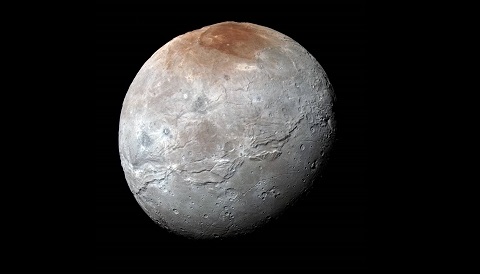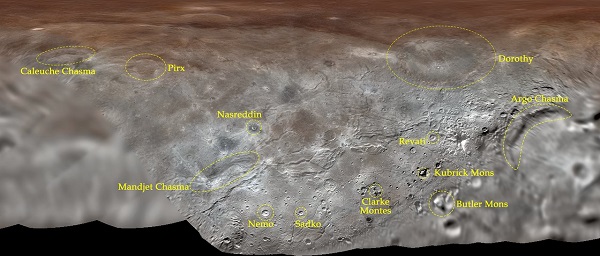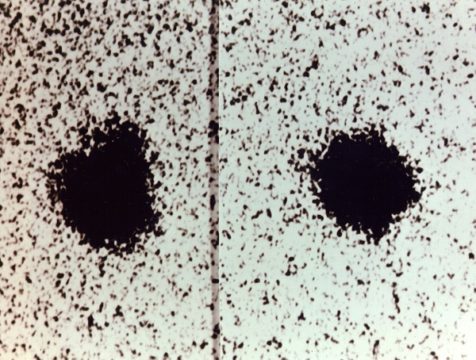The International Astronomical Union has approved names for features on Pluto's largest moon, Charon.

NASA / JHUAPL / SwRI
What's in a name? On July 14, 2015, NASA's New Horizons spacecraft completed a whirlwind flyby of Pluto and its moons, revealing these distant worlds in dramatic detail.
Now, the International Astronomical Union (IAU) has announced approval of names for a dozen features on Pluto's moon Charon. These features include craters, valleys, and crevices adorning the large moon. Many of the names were initially proposed and informally used by the New Horizons team to refer to features on the moon. The IAU Working Group for Planetary System Nomenclature approved the names this month.
Naming Charon
The Our Pluto online naming campaign, conducted in 2015, collected many of the proposed names. (Luckily, no one suggested "Kuiper McKuiper Belt-Face.") With IAU approval, these feature names follow the established themes for naming features on the moon:
- Authors and artists associated with space exploration
- Fictional and mythological explorers and vessels
- Milestones or destinations in exploration
There was also a minor controversy surrounding some of the names from modern popular culture, which the team proposed and used informally, such as Spock and Vader Crater... but who wouldn't want to call Mordor Macula home? The IAU working group hasn't formally approved these names as of yet.
New Horizons team leader Alan Stern was instrumental in getting the names pushed through IAU approval, along with SETI researcher and IAU liaison Mark Showalter and team members Amanda Zangari, Paul Schenk, Cathy Olkin, Jeff Moore, William McKinnon, Will Grundy, and Ross Beyer.
In a recent press release, IAU Working Group Chair Rita Schulz said of the decision, “I am pleased that the features on Charon have been named with international spirit.”

NASA / Johns Hopkins University Applied Physics Laboratory / Southwest Research Institute.
Here's a brief rundown of the recently named features:
Argo Chasma: Named after the ship from the Greek myth of Jason and the Argonauts.
Butler Mons: honoring science fiction author Octavia E. Butler, author of the Xenogenesis trilogy and the first science fiction author to receive a MacArthur fellowship.
Caleuche Chasma: named after a mythical ghost ship said to sail around the small island of Chilo.
Clarke Mons: honoring Arthur C. Clarke, science fiction writer and author of 2001: A Space Odyssey, Childhood's End, and Rendezvous With Rama.
Dorthy Crater: named after Dorothy Gale, the protagonist from The Wizard of Oz.
Kubrick Mons: named after Stanley Kubrick, the director of 2001: A Space Odyssey.
Mandjet Chasma: named after the boat in Egyptian mythology that carried the Sun god Ra across the sky every day.
Nasreddin Crater: named after the satirical traveler from humorous Middle Eastern tales.
Nemo Crater: Named after the captain of the Nautilus from Jules Verne's Twenty Thousand Leagues Under the Sea.
Pirx Crater: Named after a character from stories by the science fiction author Stanislaw Lem.
Revati Crater: Named after a protagonist of the Hindu epic Mahabharata.
Sadko Crater: Named after the adventurer from the Russian myth Bylina.
Official names for features on Pluto were announced in late 2017.
Charon's Characteristics
James Christy discovered the 750-mile- (1,200-kilometer-) diameter moon Charon using the 61-inch telescope at the U.S. Naval Observatory Flagstaff Station on June 22, 1978. At the time of discovery, Charon appeared simply as an indistinct fuzzy "lump" on the side of Pluto. The Hubble Space Telescope later led to the discovery of four additional moons; interestingly, New Horizons did not add to the number of known moons around Pluto.

U.S. Naval Observatory
There is a minor controversy as to just how to pronounce Charon that came up again during the 2015 flyby: discoverer James Christy uses a soft "sh" sound, as the mythological name also honors his wife Charlene whose nickname is "Char." However, the pronunciation of Charon, the ferryman who plies the river Styx from Greek mythology, is said with a hard "ch" sound.
Since Charon is 12% the mass of Pluto and orbits just 12,160 miles (19,570 kilometers) away, Pluto and Charon circle a mutual barycenter that lies between the two objects. Charon is relatively large with respect to its parent body compared to most moons. The next runner up in our solar system is our Moon, which is just over a quarter the diameter and 1/80th the mass of Earth.
Onward for New Horizons
There's more to come, as New Horizons is set to perform the most distant reconnaissance ever when it flies 2,200 miles from the newly nicknamed Ultima Thule (the Kuiper Belt object officially known as 2014 MU69) on New Year's Day 2019.
It'll be a long time before we visit Pluto and friends again. But just think: brave pioneers may one day scale Clarke Mons and descend into Mandjet Chasma.
 5
5









Comments
Anthony Barreiro
April 24, 2018 at 6:42 pm
Thanks David. I'm glad the planetary scientists and the IAU have been able to negotiate some names on Charon (hard "ch" sound please). Now maybe they can get a mediator to help them decide between "Aeolis Mons" and "Mount Sharp."
I've been thinking recently about the interdisciplinary turf war between planetary scientists and astronomers. Until fairly recently all the other planets, moons, asteroids, dwarf planets, asteroids, comets, etc., were more or less just points of light in a telescope or on a photographic plate. Not too much different from stars. Entirely appropriate to be studied by astronomers.
But now that we have sent probes to all the major planets, many of the moons, the two biggest dwarf planets, and several asteroids and comets in our own solar system, we have a lot more data about them and we're starting to understand them as highly differentiated three-dimensional objects -- much more like geology than astronomy.
I think it's time for the planetary scientists to have official control over the nomenclature of planets in our own solar system. So far as I know they don't have a single professional organization like the IAU. Maybe they should organize one.
You must be logged in to post a comment.
eduardo hernández
April 27, 2018 at 5:49 pm
Since the barycenter is above the surface of both bodies, shouldn't it be considered a binary planet or dwarf planet?
You must be logged in to post a comment.
Graham-Wolf
April 30, 2018 at 12:34 am
Interesting points, Anthony.
Agree with you on every one!!
GRaham W. Wolf at 46 South, Dunedin, NZ.
You must be logged in to post a comment.
Debra-Martin
May 2, 2018 at 7:01 pm
Why didn't anyone on the committee think to name something after Clyde Tombaugh who discovered Pluto in the first place? He deserves it. I met him in 1978 when I was a member of the family, and we attended a reception at the observatory in Chicago when Charon was introduced. We gave him a ride back to our home town where he was staying with other relatives and he told the story of what it was like when he realized his discovery and that for 45 minutes, he was the only human on the planet who knew.
You must be logged in to post a comment.
fif52
October 24, 2018 at 7:42 pm
There is always a scramble to find what is out there and name it, in this case have they forgotten to name the very large impact carter which could have been caused by Kerberos (Plutos 4th moon) which in turn dumped the resultant spoils onto Pluto's surface.
You must be logged in to post a comment.
You must be logged in to post a comment.